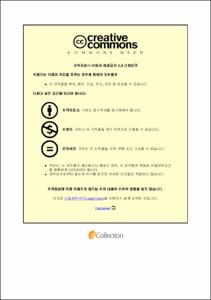발광층에 분산된 Dielectric particle의 표면상태에 따른 OLED의 발광 특성
- Alternative Title
- Surface states of dielectric particle embedded in emission layer and luminescence characteristics of OLED
- Abstract
- For similar effect of plasmon, we used space charge by embedded dielectric particle. The difference of the surface charge distribution might be changed because of the charge injection and device operating characteristics. So, we created certain scratches on the surface of embedded dielectric particles and used these to control the surface charge distribution. We prepared three solutions which has different stirring time of BaTiO3. The dopant BaTiO3’s stirring time were 6hours, 9hours and 12hours. Single layer of ITO/BaTiO3@PFO/Al device was made by using this solution. We measured applied voltage versus current and luminescence characteristics. The stirring time much longer, even the BaTiO3 particle has been grinded. At that time, grinded BaTiO3 particles were recombination each other and particles size was growth. Consequently, Dielectric particle’s effect will not occur. For this reason, the selection of a suitable stirring time is necessary. The luminescence characteristics were much better and we could observe an increasing green band. This effect appeared by PFO excimer and trap assisted recombination's improvement of embedded BaTiO3. Just embedding BaTiO3 in PFO layer, color conversion effect that blue + green was observed. If we use these improvements in current & luminescence characteristics and color conversion effects, it expected to be helpful for study of White OLED.
- Issued Date
- 2016
- Awarded Date
- 2016. 2
- Type
- Dissertation
- Keyword
- OLED Dielectric particle Color conversion
- Publisher
- 부경대학교 대학원
- Alternative Author(s)
- Su Jin Kim
- Affiliation
- 부경대학교 대학원
- Department
- 대학원 융합디스플레이공학과
- Advisor
- 정용석
- Table Of Contents
- Ⅰ. 서론
Ⅱ. 배경이론
제 1절 OLED의 구조
제 2절 OLED의 구동원리
2-1. 전하 주입 (Charge carrier injection)
2-2. 전하 이동 (Charge carrier transport)
2-3. 여기자 생성 (Exciton formation)
2-4. 발광 (Exciton decay)
제 3절 Dielectric particle BaTiO3의 특성
Ⅲ. 실험과정
제 1절. Device 제작
1-1. 사용된 재료
1-2. Solution 제작
1-3. 전극 전처리 공정
1-4. 박막 형성
제 2절. Device의 특성평가
2-1. FE-SEM과 EDS를 이용한 BaTiO3의 상태 및 분포 확인
2-2. 교반시간에 따른 J-V-L 특성 확인
Ⅳ. 결과 및 고찰
제 1절. BaTiO3의 상태 및 분포
제 2절. 교반시간에 따른 J-V-L 특성
Ⅴ. 결 론
Ⅵ. 참고문헌
- Degree
- Master
- Appears in Collections:
- 대학원 > 융합디스플레이공학과
- Files in This Item:
-
-
Download
 발광층에 분산된 Dielectric particle의 표면상태에 따른 OLED의 발광 특성.pdf
기타 데이터 / 2.22 MB / Adobe PDF
발광층에 분산된 Dielectric particle의 표면상태에 따른 OLED의 발광 특성.pdf
기타 데이터 / 2.22 MB / Adobe PDF
-
Items in Repository are protected by copyright, with all rights reserved, unless otherwise indicated.